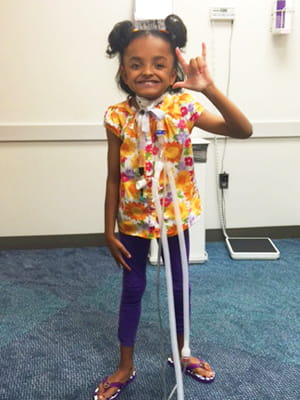"Deonċ is a frequent flyer at Texas Children’s Hospital," said Desiree, of her nine-year-old daughter. Since Deonċ was diagnosed with a rare genetic disorder known as Jarcho-Levin Syndrome at birth, the family was accustomed to hospital visits and check-ups. Jarcho-Levin Syndrome is a rare condition in which the lungs and rib cage are too small to support a growing body, and requires a ventilator as well as surgery every six months to expand Deonċ’s chest cavity, allowing her lungs to grow.

Deonċ was treated for sepsis at Texas Children’s Hospital.
So when the family took Deonċ in for a routine outpatient procedure on her gastrostomy tube, they assumed it would be business as usual. "The procedure was very quick, only about an hour," Desiree recalled. "We were all exhausted, so I was happy that we were discharged soon after with some pretty simple instructions and things to look out for, including fever."
At home, Deonċ’s temperature began to rise, and she developed a bright red rash all over her body on the third day after the surgery. The family headed back to the emergency room, just to be safe. "They told me that Deonċ had an infection and would have to be admitted, but no one told me that they admitted her because she had sepsis until much later," Desiree reflected.
After a few days in the hospital, Desiree heard a team of physicians and nurses discussing sepsis during a check-in on Deonċ. She immediately asked a resident to explain what was happening to her daughter. "That was the first time I heard them use the word sepsis," she said. "I wish I had known that Deonċ had sepsis, so I could better prepare my family for the complications that were going to follow."
Deonċ developed sepsis as a result of her routine surgical procedure. She stayed in the hospital for two weeks, during which her mom juggled being a caregiver at the hospital and caring for her other children at home. The follow-up care at home was very thorough, and the hospital’s physician’s assistant continued to check in with Desiree. This was comforting, and her family appreciated the open discussion about their daughter’s care.
"I wish the hospital had told me that sepsis was a possibility after Deonċ’s surgery, because that might have triggered me to bring her in earlier, when she experienced a minor temperature change," Desiree reflected. "People don’t like to use the word 'sepsis,' but educating families about potential symptoms before discharge is key to helping ensure we catch infections early."
Today, Desiree is working with Texas Children’s to educate parents and caregivers of other frequent flyers about sepsis. "Given the low awareness of sepsis, it’s important to introduce it to patients and families early and with context. That way, we can work together to make sure we catch it quickly."
Sepsis is a leading cause of death in hospitalized children, killing almost 5,000 children annually in the U.S.
Sharing these patient stories is part of the Improving Pediatric Sepsis Outcomes collaborative, a multi-year quality initiative to significantly reduce sepsis-related mortality and morbidity across children’s hospitals.

